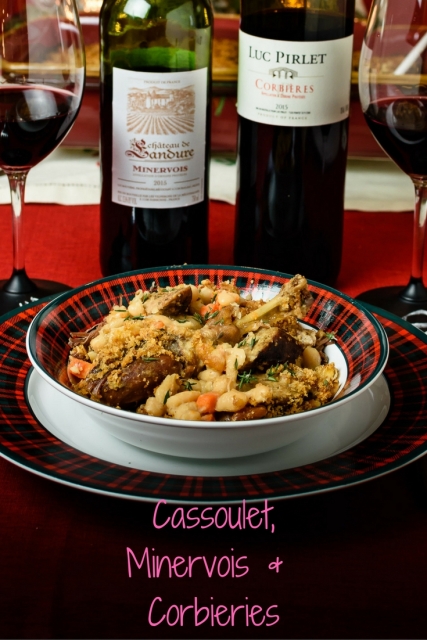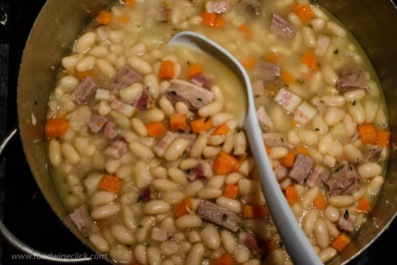Let’s Make Occitanie and Cassoulet Household Words #Winophiles

What and Where is Occitanie?
January 2018 brings our French Winophiles group to explore wines and food of Occitanie, but what is Occitanie? On January 1, 2016 the French Parliament voted to reduce the number of administrative regions in France from 22 down to 13. Presumably, this was to reduce bureaucracy, which may seem like a joke to anyone who has dealt with a bureaucratic issue in France! Occitanie was one of the regional consolidations and combined what had been the Languedoc-Roussillon and the Midi-Pyrénées in the south of France. (click on a map to see a larger version, “escape” to return)


Wine Regions in Occitanie
Confusion reigns when a wine region and the administrative region surrounding it have the same name. The Languedoc-Roussillon wine region was an area of winegrowing within the larger administrative region of the (previous) same name. Now in the new Occitanie region, the wine regions will likely retain their current names and include both the Languedoc-Roussillon and Sud-Ouest. Less confusing? Maybe…
I had fun researching the Occitanie region. With the new designation, there isn’t much available yet. I don’t usually consider Vogue magazine (article here) or Maxim magazine (article here) as my prime France travel or wine reference, but there you go. They scooped the rest of the travel world!

Languedoc, Corbieres and Minervois
This is the south of France, and the climate is a warm Mediterranean climate, so you’d expect wines and grapes to be full bodied and lush. You’ll notice some similar grapes to the southern Rhone, but not all the same and not the same proportions. The Languedoc was long established as a table wine region, stressing low prices over quality. However, that has changed in recent years. Prices are still very good, but the quality of the wines has markedly improved.

Luc Pirlet Corbieres AOP 2015 ($10 retail, sample provided by importer)
40% grenache, 30% carignan, 30% syrah
Eye: Clear, med- ruby w/ purple edge
Nose: clean, slightly pruny blue fruit, blueberry pie, vanilla, fresh herbs in the background
Mouth: Dry, medium body, medium acidity, medium tannins, ripe blue fruit, fruit pie filling, medium length clean finish.
Chateau de Landure Minervois AOP 2015 ($10 retail, sample provided by importer)
40% syrah, 40% grenache, 20% mourvedre
Eye: Clear, medium ruby w/ ruby edge
Nose: Clean, earthy nose in front with tar, forest floor, mushrooms. Fruit is behind, ripe deep blue fruit
Mouth: Dry, medium- acidity, medium+ tannins
Both of these wines seemed a natural fit with the rich, meaty slow cooked flavors of the cassoulet. Which one paired better was more a matter of personal taste. The Luc Pirlet Corbieres led with ripe fruit flavors, while the Chateau de Landure Minervois was markedly more earth influenced. My personal favorite of the two was the Minervois as I found the earthy notes intriguing and suited the duck and the sausage in the dish, but our group had no trouble finishing both wines!
Disclosure: The wines for this post were provided as samples by the importer. All opinions are my own.
Cassoulet
Cassoulet is a traditional peasant dish from the Occitanie region consisting of some type of long cooked meat in a stew of white beans. Every town in Occitanie claims a different combination as “the true version”. The most well known features beans of course, along with sausage, duck confit, and perhaps a braised ham bone. The meats used vary from town to town, some versions include a top layer of browned bread crumbs.
Cassoulet is a French version of chili mania we see in the US. Cassoulet cook-offs are held, rivalries between towns, there is even a Cassoulet brotherhood and a Cassoulet academy working to promote and defend the traditional product!
Strangely, almost everyone knows what cassoulet is and many have ordered it in a restaurant, but few cooks have made their own. Even among the excellent cooks in our French Winophiles group, this month was our first attempt at the dish!

Cassoulet Recipes
David Lebovitz book “My Paris Kitchen” is one of my favorite French cookbooks, available at Amazon here . David weaves stories into many of the recipes, giving the reader a bit more background into the dish. Our son, Peter (currently living in France), and I both have this cookbook and we occasionally will cook the same dish on both sides of the Atlantic! I highly recommend this book, but if you’d like to see for yourself, the recipes for counterfeit duck confit (part 1 of cassoulet) is posted at NPR here and the cassoulet recipe (part 2) is posted at Epicurious here. Both were posted with permission from the author. Give cassoulet a try! It does take some time, but it’s an easy dish to prepare and your family and friends will love it. My advice? Make the full recipe and enjoy the leftovers!

David Lebovitz’ shares favorites from his kitchen
French Winophiles Tackle Occitanie and Cassoulet
Here are the selected stories from the Winophiles writers this month:
- Wendy from A Day in the Life on the Farm: A Classic Pairing; Revisiting Languedoc
- Lauren from The Swirling Dervish: Warming Up with the Wines of Corbieres and Minervois
- Camilla from Culinary Adventures with Camilla: Conquering Cassoulet Alongside the 2014 Minervois le Chateau d’Albas
- Martin from ENOFYLZ Wine Blog: What Grows Together, Goes Together – Slow Cooker Cassoulet Paired With Affordable Occitanie Wines #Winophiles
- Michelle from Rockin Red Blog: Spending January in Languedoc Drinking Wine and Eating Cassoulet
- Jeff from FoodWineClick: Let’s Make Occitanie and Cassoulet Household Words
- Nicole from Somm’s Table: Kicking Off 2018 with Corbieres and Minervois
- Jane from Always Ravenous: Hearty Red Wines of Corbières and Minervois Paired with Cassoulet
- Lynn from Savor the Harvest: Corbières and Minervois – Where Syrah and Carignan Shine
- David from Cooking Chat: Chicken Cassoulet Paired with Languedoc Wine
- Rupal from Journeys of a Syrah Queen: Staying Warm the French Way – Cassoulet and Wine
- Liz from What’s in that Bottle: Let’s Learn About Wines from Languedoc #Winophiles
- Amber from Napa Food and Vine: A Tale of Two Wines
- Susannah from Avvinare: Mas Du Bosquet – An Unexpected Find From Minervois
- Gwen from Wine Predator: Cassoulet Domesticates the Wild Wines of Minervois and Corbières
- Jill from L’Occasion: Eat, Drink, Travel the South of France: Minervois and Corbières
Bonus Dessert
We prepared and enjoyed our cassoulet over the holidays. Our son, Peter, was visiting from France, so he decided to add another treat to our dinner, Bûche de Noël, also from David’s cookbook!

Comments
35 Responses to “Let’s Make Occitanie and Cassoulet Household Words #Winophiles”Trackbacks
Check out what others are saying...-
[…] Jeff from FoodWineClick: Let’s Make Occitanie and Cassoulet Household Words […]
-
[…] Jeff from FoodWineClick: Let’s Make Occitanie and Cassoulet Household Words […]
-
[…] Jeff from FoodWineClick: Let’s Make Occitanie and Cassoulet Household Words […]
-
[…] Jeff from FoodWineClick: Let’s Make Occitanie and Cassoulet Household Words […]
-
[…] Jeff from FoodWineClick: Let’s Make Occitanie and Cassoulet Household Words […]
-
[…] Jeff from FoodWineClick: Let’s Make Occitanie and Cassoulet Household Words […]
-
[…] from FoodWineClick: Let’s Make Occitanie and Cassoulet Household […]
-
[…] Jeff from FoodWineClick: Let’s Make Occitanie and Cassoulet Household Words […]
-
[…] Jeff from FoodWineClick: Let’s Make Occitanie and Cassoulet Household Words […]
-
[…] Wine, Click describes Occitanie, the new administrative unit in the South of France that includes Languedoc-Roussillion and […]



















Winner winner duck dinner! Leave it to gov to cause confusion. Great article as always. Your cassoulet looks amazing. I know how much you enjoy that cook book. And the cake you and Peter made is outstanding. I wish we lived closer so we could dine at your house regularly!
Thanks, Michelle. Peter and I both have David’s book. For the holidays, we both acquired Julia Child’s classic so we can continue to explore French classics from opposite sides of the Atlantic.
Sounds like quality father son intercontinental bonding.
What a wonderful family feast….so glad you got to spend time with your son.
Thanks, Wendy. Both Julie and I loved Peter’s visit.
How special to make with your son. I will have to look up the book, as I love trying new recipes. Wonderful article as always. Cheers!!
Thanks Rupal! We felt so lucky to have both our “kids” home over the holidays.
That cassoulet looks divine! And $10 for each of those wines? That’s a crazy good deal.
Thanks, Rob. I’m glad you were one of Liz’s guests at her shindig!
Thanks for explaining the “simplification” methods behind the renaming of the region. 🙂 I really like what you did with the snapshots of your cooking process, where a few lines of text pop up to describe what you’re doing. Cool! And, as always, the photos are top-notch.
Thanks, Lauren!
Your son and you should start doing pop-up dinners! Stellar photos, food looks fabulous Jeff. David Lebovitz is in my Flipboard feed, he’s a great story teller as you say. Appreciate the information about French administrative regions changing.
Thanks, Lynn. Unfortunately, Peter is at the receiving end of French bureaucracy right now. We’re hoping for a good resolution!
Ah, man! I can say I feel his pain! I’ll send positive resolution thoughts his way ;-D
What a lovely family feast with the cassoulet and Bûche de Noël. Lucky!! Thanks for the info on the newly formed region, too, I was horribly confused.
Thanks, Cam. We’ll have to watch and see how things develop with the region, the wine regions, etc…
Great, clear explanation of the new Occitanie department – and beautiful food pix, per usual!
Excellent explanation of new Occitanie department and your food pix are gorgeous per usual!
thanks, Liz!
I am certain you made a delish cassoulet! Your spread looks gorgeous too. I’ve followed Peter on twitter too!
This whole renaming thing is so complicated, and parts of Provence are undergoing the same thing now.
Fun month – enjoyed your post very much.
Thanks Jill! We can be the guinea pigs for the new regions, as we travel virtually through their information!
Everything here looks so beautiful and festive. Of course the wines and cassoulet look amazing, and I love the tradition you share with your son of cooking the same dish on two sides of the ocean! I also have fond memories of making a bouche de Noel with my mom as kid, so that really warmed my heart as well!
Great maps illustrating the before and after of the new Occitanie wine region and all of France for that matter. Long been a fan of David Lebovitz, his blog and cookbooks. I referred to his cassoulet recipe when making mine and made his Bûche de Noël with my daughter for the third year in a row, a fun holiday tradition and a delicious cake!
It’s so cool that you and Peter sometime prepare the same dish. Your cassoulet looks amazing. I’m not much for purchasing cookbooks (I’m not very good at using them to the extent they are intended) but I might consider the Lebovitz. It sounds great. I likely would have preferred the Minervois too! Cheers my friend!
Good explanation of the name change. I didn’t pick up on it until last week’s Twitter chat! I’ve been a fan of Languedoc wines for awhile, good source for values. Your cassoulet looks great!